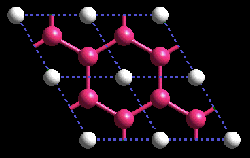Superconducting Serendipity in MgB_{2}

Six months ago, researchers worldwide were thrilled by the discovery that magnesium boride ( ) became superconducting at a temperature higher than traditional theories predicted was possible. Now two papers appearing in the 2 and 16 July print issues of PRL explain why the material superconducts at these high temperatures. A vibration in ’s lattice structure is perfectly coupled with its conducting electrons, allowing them to pass effortlessly through the material. The lattice vibration measurements are among the final steps to understanding and will help physicists plan future applications.
becomes superconducting at 40 K, a temperature lower than the highest temperature superconductors but still twice as high as similar materials. It’s cheap to manufacture, easy to work with, and will probably become the alloy of choice for the next generation of superconducting devices. is so impressive that theorists wondered if it came from a new class of superconductors. But experiments showed that it obeyed classical theory with just one exception: It became superconducting at a temperature 33% warmer than the theory seemed to allow. How could this simple compound perform at such high temperatures?
In a paper appearing in the 2 July PRL, Ray Osborn and his team at Argonne National Laboratory in Illinois revealed that ’s secret lies in the relationship between its electrons and its nuclei. Magnesium boride is a crystal lattice that resembles layered honeycombs. The honeycomb sheets are made of Boron molecules and are held together by magnesium. When an electron whizzes by a Boron atom it slightly attracts the positive nucleus, in effect “plucking” the lattice like the string of a guitar. The nucleus snaps back, triggering a vibration in the crystal that can pull a second electron behind the first. The two electrons form a so-called Cooper pair–a duo that travels without resistance through Osborn’s group determined the vibrational energies of the lattice by measuring the energy loss of neutrons bouncing off it. They then used a simple model to determine the ease with which electrons could pluck the lattice and found that it was very easy indeed–a fact that allows to superconduct at relatively high temperatures.
An independent paper in the 16 July PRL confirms the Argonne group’s neutron scattering results and offers a more detailed picture using a model of based on the fundamental laws of superconductivity. The collaboration, led by Jeff Lynn and Taner Yildirim of the National Institute of Standards and Technology in Gaithersburg, MD, shows that the properties of the conducting electrons are just right to connect with a specific lattice vibration. In this vibration, two boron atoms draw close together at the perfect time to allow electrons to jump the gap between them. That cooperative relationship between the electrons and the lattice creates strong cooper pairs and enormous vibrations. According to Lynn, the vibrations are so large that they could literally tear the lattice apart if it weren’t for the fact that other possible vibrations remain small.
It’s pure serendipity that these vibrations are perfect for electron conduction, while others are limited, says Lynn, who doubts much can be done to raise the superconducting temperatures of But Warren Pickett of the University of California at Davis believes that it may be possible to improve upon this nearly perfect relationship. “It’s still early in the game,” says Pickett,” and it’s not unrealistic to hope that there will be some improvements.”
–Geoff Brumfiel


